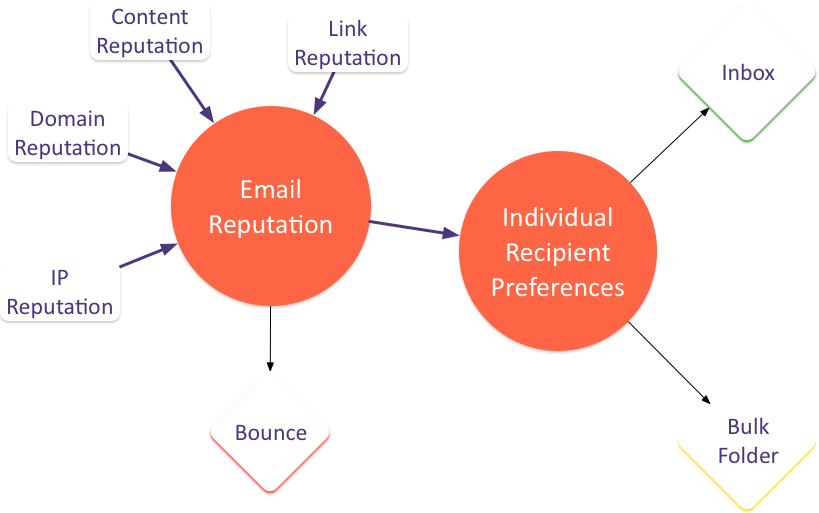Updating the filtering model
One thing I really like about going to conferences is they’re often one of the few times I get to sit and think about the bigger email picture. Hearing other people talk about their marketing experiences, their email experiences, and their blocking experiences usually triggers big picture style thoughts.
Earlier this week I was at Activate18, hosted by Iterable. The sessions I attended were interesting and insightful. Of course, I went to the deliverability session. While listening to the presentation, I realized my previous model of email filtering needed to be updated.
The old model
The old model was pretty simple. It was based on the idea that ISPs ask two fundamental questions about email when it comes in.
- Is it safe?
- Is it wanted?
If the answer to both those questions is yes, the mail is delivered to the inbox.
Safe is something we don’t talk much about in the marketing space, because generally our mail is safe. But our mail has to go through the exact same filters that are set out to catch the bad guys. And sometimes we do things that trigger that set of filters unintentionally.
The wanted is where marketers can really shine. ISPs look at their user behavior to determine if mail is wanted or not. While the measurements are slightly different than what marketers use, Marketers must also look at how wanted mail is. Engagement with the email is part of it. But, you can also use other metrics you have. Do they visit your website? Are they active on your FB page? What other data do we have that says this person is engaged with your brand and won’t object to increased volume.
Spammers send unwanted mail. Spammers send mail to a lot of addresses where the address owner doesn’t log in. Spammers send mail to people who don’t want it, so they delete it immediately. If you are sending lots of mail and your recipient demographic looks like the typical spammer recipient demographic, then your mail will be treated like spam. It’s ALL about the recipient. That’s what the ISP uses to measure your mail. And if your recipients are reacting to your mail in the same way they react to spammer mail, then you’re going to face deliverability challenges.
Increasing volume is expected, but you need to be strategic with how you increase it. I’m working with one of my clients right now to help them with the final touches on the holiday marketing program. They are increasing mail, but we made some changes to their proposed program to protect them against deliverability challenges. They’re in the early stages of warmup (yes, you need to warmup for significant volume changes!) and it’s looking good.
(That’s from an email I wrote to answer a question on the Only Influencers mailing list back in 2015)
The newer model
This week, though, I realized that another question snuck into the equation. The ISPs are still asking if mail is safe. Does it have harmful content? Phishing? Viruses? Is it coming from a botnet? ISPs use IP reputation and domain/URL reputation to answer the bulk of these questions during the SMTP transaction. If an ISP determines the mail isn’t safe, they’ll reject it out of hand.
But with technology improvements and machine learning, ISPs are able to split the second question into two sub questions.
- Is it unsolicited?
- Is it wanted by the recipient?
The unsolicited piece was always part of the equation. Many of the metrics used to answer the “is it wanted” question were actually trying to determine if the mail was unsolicited. These measurements include the things we talk about: bounce rate, complaint rate, unknown user rate. There are two reasons I think this is worth pointing out. The first is that I have often glossed over how much unsolicited mail “legitimate” senders actually send. Every company who purchases a list, who uses lead gen, who collects addresses at point of sale send unsolicited email. They may not mean to, but they do. The second reason is this is the piece of spam filtering that data hygiene companies are addressing. Everyone who cleans your list, identifies bounces, finds bad users, they’re specifically addressing this filtering. And many senders don’t understand why their mail is still going to bulk even after they’ve purchased very expensive hygiene services.
The reality is, that hygiene services make mail look less unsolicited, by removing many of the markers that tell ISPs the mail is unsolicited. But that doesn’t make the mail any more wanted by the recipient. Hence the current focus on engagement and individual delivery metrics. These are metrics that can’t be faked by the sender. Third parties can’t identify those recipients that want a particular piece of mail. And, with privacy laws like GDPR, it’s unlikely those business models will be cost effective.
